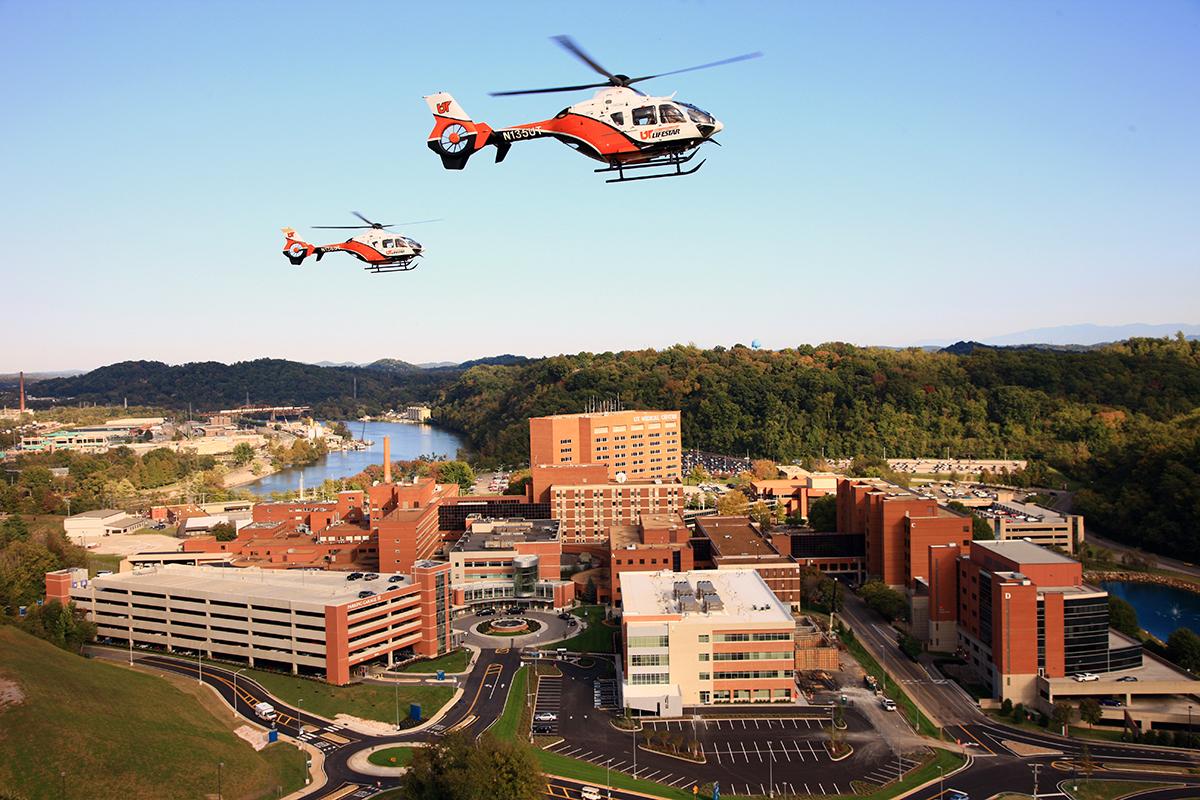The UT LIFESTAR air medical transport team has served The University of Tennessee Medical Center and the East Tennessee region since 1984. Follow this timeline to learn more about the history of this trailblazing aeromedical service.
UT LIFESTAR Awards and Timeline
Sept. 1, 1984: The LIFESTAR program, founded by Dr. Robert Lash, began service with the arrival of a Bell 222 aircraft. The LIFESTAR program was one of the few civilian single pilot Instrument Flight Rules (or IFR) programs in the country.
Sept. 1, 1984 (2 hrs. later): The LIFESTAR program ceased operation with the crash landing and subsequent fire which destroyed the aforementioned Bell 222. It was later determined that the faulty setting of a torque limiter before the aircraft’s delivery caused the accident. While there were injuries, none were serious thanks to the use of helmets and Nomex flight suits. Within three weeks a temporary L3 Jet Ranger arrived to be used until a replacement Bell 222 could be delivered in early 1985. Initially, LIFESTAR was the only medical helicopter within a 150 mile radius of Knoxville.
Oct. 1 1984: LIFESTAR flew its first patient, a cardiac case. The charge for this flight $417.18. In its first month of operation, LIFESTAR received 26 requests and flew 22 patients.
April 1986: LIFESTAR appeared on the cover of Hospital Aviation magazine.
1987: Due to ongoing problems with the 222’s LTS 101 engines the program ceased operations for six weeks. At this time a decision was made to change to Bell 412 aircraft.
April 1988: The first Bell 412 arrived. The 412 was also single pilot IFR rated and one of the few civilian medical helicopters in the country equipped with a liquid oxygen system. Because of the large area being covered by so few aircraft the 412 was equipped to carry 3 patients. Also in the spring of 1988, LIFESTAR’s sponsoring hospital, UT Medical Center, was designated as a Level I Trauma Center.
1989: LIFESTAR and the Manchester, England Ambulance Service participated in a paramedic exchange program. LIFESTAR paramedics Jeff Gregory and Rick Harrington represented LIFESTAR in this event where they observed and participated in EMS activities. Also in 1989 LIFESTAR responded to a massive accident in Calhoun, Tennessee involving nearly 100 vehicles and 12 fatalities.
April 1992: LIFESTAR program founder, Dr. Robert Lash, died. In 1993 Dr. Christopher Brooks assumed the role of program director. Mr. Norman Majors became the hospital administrator overseeing the LIFESTAR program.
November 1993: LIFESTAR added a fixed wing air ambulance (Navajo). This operation was later terminated.
October 1994: LIFESTAR finalized purchase of a 2nd Bell 412. Also in 1994 LIFESTAR Paramedics began serving as team Paramedics for the University Of Tennessee Athletic Department including the UT Vols football team.
November 1996: The Reader’s Digest featured an article about a gravely injured LIFESTAR patient whose heart was transplanted into her critically ill father.
1998: LIFESTAR opened a remote base in Morristown, Tennessee.
1999: LIFESTAR and UT Medical Center implemented automatic acceptance protocols for the LIFESTAR communications center. This greatly facilitated acceptance of patients from outlying hospitals to UTMC and remains an extremely important factor in LIFESTAR’s flight volume — often exceeding 200 flights a month.
2002: Because of age and cost of operation, it was decided to change from Bell 412 aircraft to the Bell 430. A Bell L4 was also placed in service as a backup aircraft.
2003: The first 430 arrived in June; it had been previously owned by professional golfer Greg (The Shark) Norman. In September 2003 the 2nd 430 arrived. Also in 2003 GPS approaches to five area cities served by LIFESTAR were placed in service. Finally in 2003, Jeff Gregory, became program director while Dr. Brooks retained the position of medical director.
2005: A second remote LIFESTAR base was opened in Sevierville, Tennessee, home of Dollywood and gateway to the Great Smoky Mountains National Park.
2006: LIFESTAR began using night vision goggles after receiving a homeland security grant. In September 2006 the communications center became one of four state Regional Medical Control Centers for Tennessee. Finally, a third base opened in Sweetwater, Tennessee.
2007: In May UT Medical Center and Med-Trans Corporation formed a partnership to operate the UT LIFESTAR program. At this time it was decided to replace the Bell 430’s with Bell 407’s and EC 135’s. Finally, UT LIFESTAR Program Director Jeff Gregory received the Tennessee Ambulance Service Association Administrator of the Year Award.
2008: UT LIFESTAR received the Region II EMS Director’s Service Of The Year Award. In October it opened its 4th base in Anderson County, Tennessee.
2009: UT LIFESTAR received its first EC 135 and the second in March of 2010. Rick Harrington received The EMS Lifetime Achievement Award from the Tennessee Region II EMS Directors Association.
2015: A fifth helicopter was placed into operation at the Rockwood Airport in Roane County.
Today: UT LIFESTAR operates five aircraft 24/7, strategically positioned at five bases throughout the region, which allows the fleet to rapidly reach those needing air medical transport.
